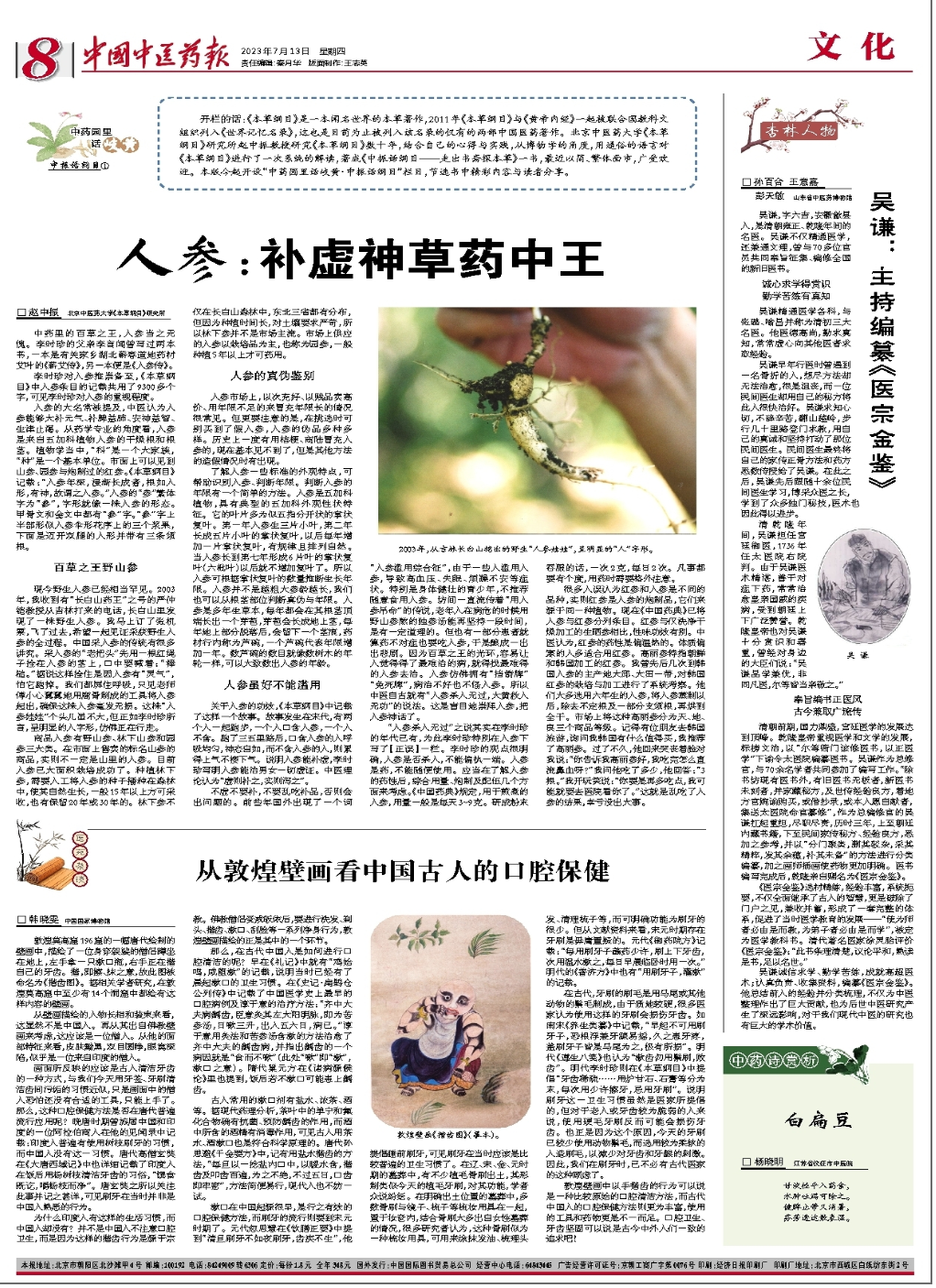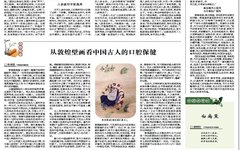 Click the above “Public Account” to subscribe!
Click the above “Public Account” to subscribe!
Source|China Traditional Chinese Medicine News
Text|Zhao Zhongzhen, Institute of Compendium of Materia Medica, Beijing University of Chinese Medicine
Introduction: The Compendium of Materia Medica is a world-renowned herbal text. In 2011, it was included in the UNESCO Memory of the World Register along with the Huangdi Neijing, making it one of only two Chinese medical texts to receive this honor. Professor Zhao Zhongzhen of the Institute of Compendium of Materia Medica at Beijing University of Chinese Medicine has studied the Compendium for decades. Combining his insights and practices, he has provided a systematic interpretation of the text from a natural history perspective, using accessible language in his book “Zhongzhen Talks on the Compendium – Exploring Materia Medica Beyond the Study Room,” which has recently been published in both simplified and traditional Chinese and has been well received. This column, “Talking about Qi Huang in the Herbal Garden – Zhongzhen Talks on the Compendium,” will share exciting excerpts from the book with readers.

Among the herbs, ginseng is undoubtedly the king. Li Shizhen’s father, Li Yanwen, wrote two books, one about the local medicinal herb mugwort from his hometown in Qichun, Hubei, titled “The Transmission of Qichun Mugwort,” and the other titled “The Transmission of Ginseng.”
Li Shizhen held ginseng in high regard, dedicating over 9,300 characters to its entry in the Compendium of Materia Medica, indicating the importance he placed on it.
The name of ginseng is frequently mentioned. Traditional Chinese Medicine (TCM) believes that ginseng can greatly replenish vital energy (yuanqi), tonify the spleen and lungs, calm the mind, enhance intelligence, and generate fluids to quench thirst. From a pharmacological perspective, ginseng is the dried root and rhizome of the plant Panax ginseng, which belongs to the Araliaceae family. In botany, a “family” is a large group, while a “species” is a basic unit. On the market, one can find wild ginseng, cultivated ginseng, and processed red ginseng. The Compendium of Materia Medica states: “As ginseng ages, it gradually matures, and its root resembles a human shape, hence it is called ginseng.” The traditional character for ginseng is “參,” which visually resembles the shape of a ginseng plant. The character “參” appears in both oracle bone script and bronze inscriptions. The upper part of the character resembles the three berries of the umbel flower cluster of ginseng, while the lower part depicts a human figure with legs spread and three fibrous roots.
The King of Herbs: Wild Ginseng
Today, wild ginseng is quite rare. In 2003, I received a call from Professor Yan Zhongkai, known as the “King of Medicinal Herbs in Changbai Mountain,” who discovered a wild ginseng plant in the Changbai Mountains. I immediately booked a flight to witness the entire process of harvesting wild ginseng. There are many traditions associated with ginseng harvesting in China. The “old master” who harvests ginseng first ties a red string around the stem of the ginseng and shouts, “Hammer.” It is said that this is to secure the ginseng, as it is believed to possess “spiritual energy” and might run away. We all held our breath as the master carefully used a tool made from deer bone to extract the ginseng, ensuring that it was unharmed. This “ginseng doll” was small but, as Li Shizhen described, had a distinct human shape, as if it were walking.
Commercial ginseng is categorized into three main types: wild ginseng, forest-grown ginseng, and cultivated ginseng. Products labeled as mountain ginseng on the market may not necessarily be from the mountains. Currently, ginseng has been successfully cultivated on a large scale. Forest-grown ginseng requires manual sowing of ginseng seeds in forests for natural growth, typically harvested after 15 years, with some being retained for 20 or 30 years. Forest-grown ginseng is distributed not only in the Changbai Mountain forests but also across the three northeastern provinces. However, due to the long cultivation period and strict soil requirements, forest-grown ginseng is not the mainstream market product. The ginseng supplied in the market is primarily cultivated ginseng, also known as garden ginseng, which is generally harvested after five years of cultivation.
Identifying Genuine Ginseng
In the ginseng market, it is common to find inferior products sold at high prices, and younger ginseng being passed off as older. It is crucial to be cautious when selecting ginseng to avoid purchasing counterfeit products, as there are many types of fake ginseng. Historically, there were instances of using Platycodon grandiflorum and Euphorbiae to impersonate ginseng, but these are now rare. However, other forms of counterfeiting still occur.
Understanding some standard external characteristics of ginseng can help in identifying it and determining its age. A simple method to assess the age of ginseng is based on its typical Araliaceae characteristics. Ginseng leaves are usually palmate compound leaves that resemble five fingers. In the first year, ginseng produces three small leaves, and in the second year, it grows into five small leaves. Each subsequent year, it adds one palmate compound leaf in a regular and natural arrangement. When ginseng reaches the seventh year, it forms six leaves (liupiliye) and does not increase the number of compound leaves thereafter. Therefore, the number of palmate compound leaves can be used to infer the growth age of ginseng. It is a misconception that larger ginseng indicates older age; we can also determine authenticity and age from the root and rhizome. Ginseng is a perennial herb that grows a bud at the top of its rhizome each year, which develops into an above-ground stem. After the above-ground part falls off each year, it leaves a stem scar, known in the herbal industry as a “luwan,” with each luwan representing an additional year of age. Counting the number of luwan is akin to counting the growth rings of a tree, allowing for a rough estimate of ginseng’s age.
Ginseng is Beneficial but Should Not Be Abused
Regarding the effects of ginseng, the Compendium of Materia Medica records a story. In the Song Dynasty, two people were running; one held ginseng in his mouth while the other did not. After running for three to five miles, the one with ginseng maintained steady breathing and appeared relaxed, while the other was out of breath. This illustrates that ginseng can replenish deficiency. Li Shizhen noted that ginseng can treat all forms of deficiency in both men and women. TCM theory states, “If there is deficiency, replenish it; if there is excess, drain it.”
Do not supplement if you are not deficient, and avoid indiscriminate consumption of tonics, as this can lead to problems. In recent years, a term called “ginseng abuse syndrome” has emerged abroad, where some individuals have experienced symptoms such as hypertension, insomnia, and restlessness due to excessive ginseng use. Particularly for robust young people, ginseng is not recommended for casual consumption. There has long been a saying that “ginseng can prolong life,” suggesting that elderly individuals can use wild ginseng to brew a special ginseng soup to sustain themselves for a while, which has some truth to it. However, some patients insist on consuming ginseng even when it is not suitable for their condition, leading to tragic outcomes. The aura of the king of herbs can easily lead people to believe that the most difficult diseases must be treated with the rarest ginseng. Ginseng seems to serve as a “shield” or “get out of jail free card,” where if the illness does not improve, it is not blamed on ginseng. Thus, TCM has long held the saying, “Ginseng kills without fault, rhubarb saves without merit.” This reflects a blind worship of ginseng, mythologizing it.
The saying “ginseng kills without fault” has existed since Li Shizhen’s time, and he specifically included a section on “Correct and Incorrect” under ginseng. Li Shizhen’s viewpoint is clear: whether ginseng is harmful cannot be viewed in isolation. Ginseng is a medicine and should not be used indiscriminately. One should consider its properties, dosage, preparation, and compatibility comprehensively. The Chinese Pharmacopoeia stipulates that for decocting ginseng, the dosage is generally 3 to 9 grams per day. If taken in powdered form, the dosage is 2 grams at a time, twice daily. Everything must have a limit, and caution is required when using medicine.
Many people mistakenly believe that red ginseng and ginseng are different species; in fact, red ginseng is a processed product of ginseng, both originating from the same plant. The current Chinese Pharmacopoeia has separated the entries for ginseng and red ginseng. Compared to raw sun-dried ginseng, red ginseng has different properties and effects. TCM believes that red ginseng has a warming nature. Individuals with a cold constitution are more suited to use red ginseng. Korean ginseng specifically refers to red ginseng processed in Korea. I have visited the main production areas of Korean ginseng in Daegu and Daejeon several times, conducting systematic studies on the cultivation and processing of Korean red ginseng. They mostly select six-year-old ginseng, which is steamed, with the fibrous roots and some of the lateral roots removed, and then dried completely. This Korean ginseng is categorized into three grades: heaven, earth, and good. I remember a friend who traveled to Korea and asked me what was worth buying; I recommended Korean ginseng. Not long after, he returned looking distressed, saying, “You told me Korean ginseng was good, but after eating it, I had a nosebleed!” I asked how much he had consumed, and he replied, “Three roots.” I joked, “If you had eaten more, I might have had to go to the hospital to see you.” This is the result of indiscriminate consumption of ginseng, and fortunately, nothing serious happened.
China Traditional Chinese Medicine News has launched an official Douyin account!
Welcome to follow us!!
Open Douyin and search for “China Traditional Chinese Medicine News”
Douyin ID: 36254766218
Editor|Xu Jing
Review|Bai Xiaoyun, Huang Bei


